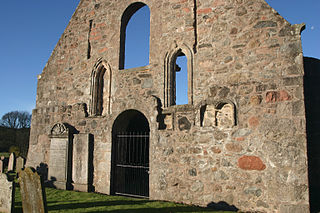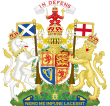Related Research Articles

The High Court of Justiciary is the supreme criminal court in Scotland. The High Court is both a trial court and a court of appeal. As a trial court, the High Court sits on circuit at Parliament House or in the adjacent former Sheriff Court building in the Old Town in Edinburgh, or in dedicated buildings in Glasgow and Aberdeen. The High Court sometimes sits in various smaller towns in Scotland, where it uses the local sheriff court building. As an appeal court, the High Court sits only in Edinburgh. On one occasion the High Court of Justiciary sat outside Scotland, at Zeist in the Netherlands during the Pan Am Flight 103 bombing trial, as the Scottish Court in the Netherlands. At Zeist the High Court sat both as a trial court, and an appeal court for the initial appeal by Abdelbaset al-Megrahi.

The Crown Office and Procurator Fiscal Service is the independent public prosecution service for Scotland, and is a Ministerial Department of the Scottish Government. The department is headed by Her Majesty's Lord Advocate, who under the Scottish legal system is responsible for prosecution, along with the area procurators fiscal. In Scotland, virtually all prosecution of criminal offences is undertaken by the Crown. Private prosecutions are extremely rare.

Anna "Nan" Shepherd was a Scottish Modernist writer and poet, best known for her seminal mountain memoir, The Living Mountain, based on experiences of hill walking in the Cairngorms. This is noted as an influence by nature writers who include Robert Macfarlane and Richard Mabey. She also wrote poetry and three novels set in small fictional communities in Northern Scotland. The landscape and weather of this area played a major role in her novels and provided a focus for her poetry. Shepherd served as a lecturer in English at the Aberdeen College of Education for most of her working life.

Iain Richard Torrance, is a retired Church of Scotland minister, theologian and academic. He is Pro-Chancellor of the University of Aberdeen, Honorary Professor of Early Christian Doctrine and Ethics at the University of Edinburgh, President and Professor of Patristics Emeritus at Princeton Theological Seminary, and an Extra Chaplain to Her Majesty Queen Elizabeth II in Scotland. He was formerly Moderator of the General Assembly of the Church of Scotland, Dean of the Chapel Royal in Scotland, and Dean of the Order of the Thistle. He is married to Morag Ann, whom he met while they were students at the University of St Andrews, and they have two children.
The High School of Glasgow is an independent, co-educational day school in Glasgow, Scotland. The original High School of Glasgow was founded as the choir school of Glasgow Cathedral in around 1124, and is the oldest school in Scotland, and the twelfth oldest in the United Kingdom. On its closure as a selective grammar school by Glasgow City Corporation in 1976, it immediately continued as a co-educational independent school as a result of fundraising activity by its Former Pupil Club and via a merge by the Club with Drewsteignton School. The school maintains a relationship with the Cathedral, where it holds an annual service of commemoration and thanksgiving in September. It counts two British Prime Ministers, two Lords President and the founder of the University of Aberdeen among its alumni.
The Justiciar of Scotia was the most senior legal office in the High Medieval Kingdom of Scotland. Scotia in this context refers to Scotland to the north of the River Forth and River Clyde. The other Justiciar positions were the Justiciar of Lothian and the Justiciar of Galloway.
The Justiciar of Lothian was an important legal office in the High Medieval Kingdom of Scotland.
William Gordon was a 16th-century Scottish noble and prelate, the last of the pre-Reformation bishops of Aberdeen owing allegiance to the Roman Catholic Church.
Alastair Peter Campbell, Lord Bracadale, QC is a retired senior Scottish judge.
William Stewart was a late medieval Scottish prelate. Born around 1490 in Glasgow, he was the son of Thomas Stewart of Minto. Details about his early life are obscure, but it is known that he attended the University of Glasgow before travelling to continental Europe to study theology and canon law. The first benefice he held was the parsonage of Lochmaben, which he was in possession of by July 1528. In the same year he became rector of Ayr, while he had received crown presentation as Provost of Lincluden Collegiate Church in July 1529, a post he would hold along with his new position as Lord High Treasurer of Scotland.

The Kingdom of Scotland was a sovereign state in northwest Europe traditionally said to have been founded in 843. Its territories expanded and shrank, but it came to occupy the northern third of the island of Great Britain, sharing a land border to the south with the Kingdom of England. It suffered many invasions by the English, but under Robert the Bruce it fought a successful War of Independence and remained an independent state throughout the late Middle Ages. Following the annexation of the Northern Isles from the Kingdom of Norway in 1472 and the final capture of the Royal Burgh of Berwick by the Kingdom of England in 1482, the territory of the Kingdom of Scotland corresponded to that of modern-day Scotland, bounded by the North Sea to the east, the Atlantic Ocean to the north and west, and the North Channel and Irish Sea to the southwest. In 1603, James VI of Scotland became King of England, joining Scotland with England in a personal union. In 1707, the two kingdoms were united to form the Kingdom of Great Britain under the terms of the Acts of Union.

Government in medieval Scotland, includes all forms of politics and administration of the minor kingdoms that emerged after the departure of the Romans from central and southern Britain in the fifth century, through the development and growth of the combined Scottish and Pictish kingdom of Alba into the kingdom of Scotland, until the adoption of the reforms of the Renaissance in the fifteenth century.

Witch trials in early modern Scotland were the judicial proceedings in Scotland between the early sixteenth century and the mid-eighteenth century concerned with crimes of witchcraft, part of a series of witch trials in Early Modern Europe. In the late middle age there were a handful of prosecutions for harm done through witchcraft, but the passing of the Witchcraft Act 1563 made witchcraft, or consulting with witches, capital crimes. The first major issue of trials under the new act were the North Berwick witch trials, beginning in 1590, in which King James VI played a major part as "victim" and investigator. He became interested in witchcraft and published a defence of witch-hunting in the Daemonologie in 1597, but he appears to have become increasingly sceptical and eventually took steps to limit prosecutions.

The great Scottish witch hunt of 1649–50 was a series of witch trials in Scotland. It is one of five major hunts identified in early modern Scotland and it probably saw the most executions in a single year.

Kincardine O'Neil Hospital was founded in the 13th century in the village of Kincardine O'Neil in Scotland. Almost certainly it served as a traveler's inn and as a hospice for elderly and "poor" men. The hospital was situated adjacent to a bridge over the River Dee and may have been a chantry for the early Bishops of Mortlach. Remains of a building can be seen abutted to the Auld Parish Church in Kincardine O'Neil. This building may have been a later or second hospital. It is also possible that these ruins may have been part of St Erchard's Church - a.k.a. St Marys' or the Auld Kirk.

George Gordon Stott, Lord Stott, PC, QC was a Scottish advocate, sheriff and Lord Advocate, the chief legal officer for the Crown and government in Scotland. In retirement Gordon Stott published three volumes of extracts from the diaries he had been keeping throughout his legal career.
Neil John Downie Kennedy, Lord Kennedy, was a Scottish advocate, legal academic and judge. He was a Professor of Law at the University of Aberdeen, and served from 1912 to 1918 as the first chairman of the Scottish Land Court.
Marie Lamont, also referred to as Mary Lawmont (1646–1662), was executed for witchcraft during the reign of Charles II just after Witchmania had peaked in the United Kingdom. Her youth at the time of her execution made her case unusual.
Anna Poole QC is a Senator of the College of Justice in Scotland. Prior to her appointment, she was a Judge of the UK Upper Tribunal, Administrative Appeals Chamber. Lady Poole was educated at Madras College, St Andrews, and at Somerville and Magdalen Colleges, Oxford.
The 1910–11 Scottish Districts season is a record of all the rugby union matches for Scotland's district teams.
References
- ↑ "Research Tools : The Glossary - J".
- ↑ McNeil, McQueen (1998), p 211
- ↑ Macfarlane (1995), pp. 93–4

